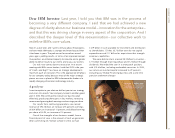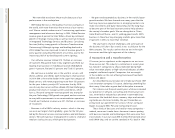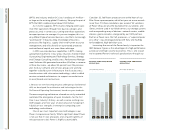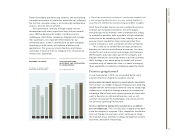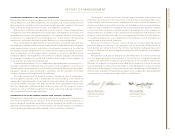IBM 2004 Annual Report Download - page 5
Download and view the complete annual report
Please find page 5 of the 2004 IBM annual report below. You can navigate through the pages in the report by either clicking on the pages listed below, or by using the keyword search tool below to find specific information within the annual report.
03
chairman’s letter
We take enormous pride in these achievements. But if you
intend to remain the innovation leader, you commit yourself
to continuous reinvention. You’ve got to do the hard work,
every day, to discover and develop new capabilities—and
new ways of working — that will keep you moving forward.
The new Lenovo will be the world’s third-largest PC busi-
ness. It will have greater global reach and greater economies
of scale, and we will continue to work together to deliver
world-class PC solutions in the marketplace. There’s no doubt
in my mind that this was the best path forward for our
personal computer business.
For IBM, our PC transaction—perhaps the most widely
commented-upon event of the year for us—was certainly
a milestone. But not, I would argue, for the reasons many
believe. We could simply have sold our PC business.
Instead, what we did was to reposition both that business
and IBM itself in ways that help each and that align with
the future trajectory of the IT market. This deal crystallizes,
as well as any single event could, the nature of our business
model, strategy and marketplace position today:
IBM is an enterprise-focused company. It is not
our strength or intention to participate directly in
consumer markets.
We are all about innovation. We are best at creating
and delivering differentiating value to our clients.
We are a global business. Much more than marketing
products and services around the world, this means
establishing deep roots locally and leveraging our
multinational presence for operational advantage.
To explain our perspective on both the IT industry and IBM’s
transformation lies beyond the scope of an annual report.
However, I do believe it is vital for anyone with an interest
in IBM to understand this long-term view and what lies
behind it—not a mere cyclical change, but a major structural
shift in our industry. That is why we created the document
“Understanding Our Company: An IBM Prospectus,” which
accompanies this year’s annual report. I encourage you
to take a look at it. I think it will help explain how we see the
world, and how that is driving our actions.
The meaning of 2004
Several major shifts—in business models, in technology
and in how they together are reshaping our industry— have
driven everything we’ve done at IBM over the past four
years. They continued to do so in 2004.
1. Because clients now demand that information technology
be intimately integrated with their business operations, we have
reshaped IBM’s business skills, assets and delivery capability.
This has involved everything from our acquisition of
PricewaterhouseCoopers Consulting in 2002, to the launch
of multiple industry- and process-specific practices and lines
of business. Some people may see this simply as IBM bulking
up in services. It is true that we needed to add a lot of deep
business expertise—and we will continue to strengthen our
hand here. But clients want more than the consultant’s strategic
advice, the systems integrator’s skills or the IT outsourcer’s
scale. They want new business designs, enabled by technol-
ogy, that give them some quantifiable competitive advantage.
They want new options and alternatives, not only in how
they manage IT, but in how they conceptualize and manage
their companies.
This is what we mean by On Demand Business. CEOs
might not use that exact term (yet), but a more responsive,
virtually integrated company is increasingly what they are
asking us to help them build. Companies like eBay, Bank
of America and METRO Group, and institutions like Miami-
Dade County and the new Museum of Modern Art are, to
one degree or another, on demand enterprises.
I want to highlight one aspect of On Demand Business,
because it represents a very large new market opportunity for
us. We call it Business Performance Transformation Services



